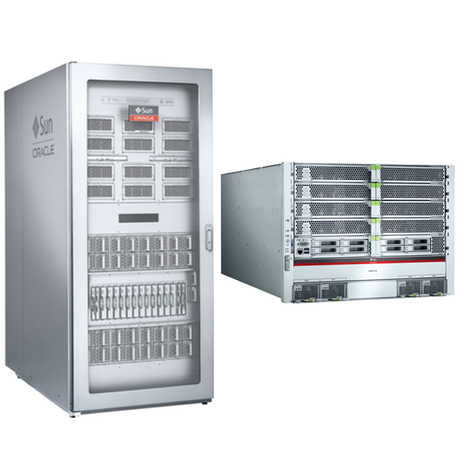Oracle’s new SPARC servers light fire under IBM

Oracle’s founder and CEO Larry Ellison today announced two new processor families and server ranges that, according to independent benchmarks, deliver markedly better bang for buck than IBM.
The new T5 and M5 platforms complement the existing T4 platform giving Oracle enterprise compute options from the entry level, through mid-range to the high-end. Interestingly, part of the performance boost Ellison boasted of comes from moving functions away from software back onto the silicon in order to increase the performance lead.
“What we plan to do to sustain and increase that leadership is start moving a lot of features of our software, features of our database, features of Java out of the software and into silicon,” said Ellison, describing this as the “ultimate optimisation”.
Ellison acknowledged that some would see this as a high-risk strategy, given that is counter to much of what we’re seeing in other parts of enterprise computing as almost every activity is being virtualised onto commodity hardware. However, Ellison countered this saying, “We’ve done this before. Encryption, a long time ago, we moved encryption out of software and onto silicon. Why can’t you do this with database query processing? Why can’t you do this compression and decompression?”
One of the biggest changes occurring in enterprise computing today is the shift from spinning drives to SSDs and RAM for storage. One of the drivers for optimising processor and software performance together is the ability to take advantage of those faster media. “We have to make significant improvements in the processor to keep up with that migration of data into faster and faster storage devices. As we move off disk onto flash, we’re talking about orders of magnitude data access performance improvements. You have to have corresponding improvements in your microprocessor,” said Ellison.
The new server products are delivered through two product families: the T5 and M5. The T5 series, Oracle’s mid-range offering, are the successors to the T4 with the M5 succeeding the M9000. The M5 is also the first new M-series hardware produced by Oracle since its acquisition of Sun in 2010.
There are three T5 systems being offered: the T5-2, T5-4 and T5-8 with the 2, 4 and 8 designators indicating the number of processor sockets. The M5-16 and M5-32 are cabinet systems for the high-end market.
During the announcement of the new hardware, Ellison noted that the new hardware had set 17 world records for performance. However, he saved most of his gloating for the apparent advantages the new T5 systems had over IBM’s P780 hardware. Among the statistics he quoted were:
- Oracle’s SPARC T5-8 is the fastest single server for Oracle Database.
- Oracle’s SPARC T5-8 is also the fastest single server for Oracle Middleware with a 12x cost performance advantage over the IBM Power 780.
- Oracle’s SPARC T5-8 server has a 2.5x price performance advantage over the IBM P780 3-node cluster, when including hardware and software costs.
- Oracle’s SPARC T5-8 server has a 7x price advantage over a similar IBM Power 780 configuration for database on a server-to-server basis.
Oracle’s Executive Vice President of Systems, John Fowler, said that after three years since the acquisition of Sun, Oracle is now starting to “really see the fruit of those investments”.
Fowler says that Oracle has been able to make performance gains by taking a different approach to how it designs its systems. In the past, Fowler says, application development and hardware design were undertaken at an arm’s length from each other. Oracle has had its software and hardware teams working together to optimise the operating system, database and hardware to work together as tightly as possible.
Oracle’s new SPARC servers will be shipping locally this week.
How digital twins are changing the way data centres are designed
Digital twins have the potential to rewrite the design rules for data centres.
Future-proofing business operations in Fiji
Fijian conglomerate Motibhai Group has modernised its IT operations with a hyperconverged...
Should AI actually be the biggest IT sustainability concern?
The broader IT sustainability conversation is disproportionately focused on AI, even as other...







